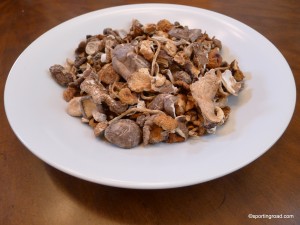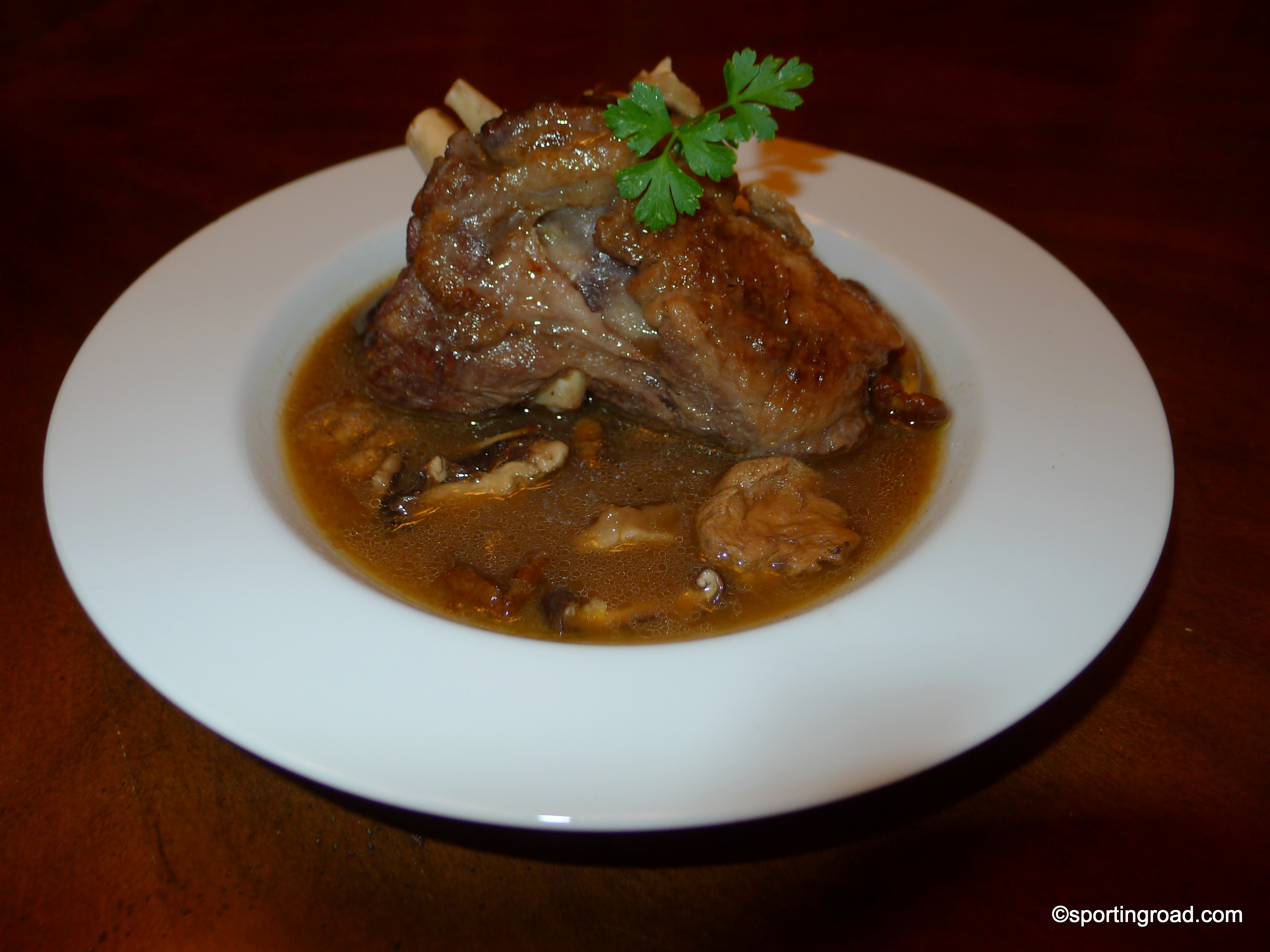A Hunter’s Road Braised Lamb Shanks
From Jim Fergus
When he hosts dinners, Mario Batali says he often makes braised dishes. “I can leave the kitchen and talk to my guests,” says Mario, “and the most remarkable fragrance fills my house.” Our friend and author, Jim Fergus, also does the same, but he didn’t get this recipe from Mario Batali, though he has had dinner with him, as Mario lives by his friend and fellow foodie, Jim Harrison. Jim credits his late French wife with this recipe for braised lamb shanks. In a recent issue of Food & Wine Magazine, Mario gives a tip for shanks in which he was using veal for osso buco but the same goes here as well, “Before the
This recipe calls for four large shanks, but there’s plenty of meat to serve 6-8 persons. When asked for this recipe, Jim claims, “I’m not very good at writing down recipes as I often just sort of wing it.” But this is his recipe:
1. Pre-heat oven to 250 degrees. Season [the room temperature] shanks with salt and pepper and dust with flour. In an enameled cast iron pot (such as a Le Creuset) or a a large regular cast iron Dutch oven with lid, heat several tablespoons of olive oil over moderate heat. Add shanks and brown on all sides–about 20 min. Depending on how many shanks you’re cooking you may need a rather large pot or just brown them in batches, as I did. [ed.-We find that even for a large pot, 4 shanks are the maximum that you can cook in this recipe and you brown them just 2 at a time. Also, you have to rough them up a bit. Hungarian grandmothers say that the secret a good pot roast is to brown the hell out of it. Similarly, you really have to brown these shanks. I was too gentle with the first several tries and 20 minutes seemed too long, as smoke started to come in the kitchen. Turn off the smoke detector, turn on the fan, and error on the side of burning them, rather than just lightly browning, as the burning, and tearing of the meat as it sticks to the pot, roughs them up, and creates pockets for the tenderness to ripen in the later cooking process. If you don’t follow this step, you will have tougher shanks. Trust me, burn ’em.]. Transfer shanks to a plate.
2. Reduce heat and add 1 large onion roughly chopped and 3-4 garlic cloves, slightly crushed, stirring until softened–5-10 min. Add about 4 cups of beef stock (I like to make fresh stock but if I don’t have time as I didn’t in the case of our lunch, I use ONLY Kitchen Basics beef stock. In my opinion it’s by far the best) and 1 cup (or maybe a little more) of red wine. Make a herb bundle with about 6 sprigs of flat parsley, 6 sprigs of thyme and 2 two bay leaves, tied with kitchen twine. (For this I cut the wide white ends of 2-3 celery stalks about 6″ long, position the herbs inside and wrap it securely with twine. But a regular tied bouquet garni works just fine too.) Add the herb bundle and 1 carrot chopped into 3″ lengths and return the shanks to the pot. Cover and transfer to oven. I made this dish the night before you arrived (like most stews and slow-cooked meats, I think it’s always better the next day) and I cooked it on low heat for about 3- 4 hrs., I think (but of course this is 8600 ft. elevation), turning the shanks a couple of times. (I’m sure I don’t need to tell you this, but as in all braised meat dishes you want only enough liquid to half-cover the meat, or even slightly less, so in case I’m off on the liquid measurements you can adjust). After cooking, I turned the oven off and just left the pot in all night so it continued cooking a little.
 3. Remove lamb shanks carefully from pot using tongs and strain cooking liquid, discarding herb bundle and all solids. After shanks have cooled, cover them and refrigerate but do not put them back in cooking liquid yet. Return cooking liquid to pot, let it cool to room temperature and then refrigerate for a couple of hours. This will allow all the fat to congeal on the surface and it’s then easy to remove. (It is very important that this dish be degreased as the lamb shanks are quite fatty.)
3. Remove lamb shanks carefully from pot using tongs and strain cooking liquid, discarding herb bundle and all solids. After shanks have cooled, cover them and refrigerate but do not put them back in cooking liquid yet. Return cooking liquid to pot, let it cool to room temperature and then refrigerate for a couple of hours. This will allow all the fat to congeal on the surface and it’s then easy to remove. (It is very important that this dish be degreased as the lamb shanks are quite fatty.)
4. I used 2 plastic containers of dried Morels and 2 of Porcini, (though I would have used all morels if they’d had more at the store) Chanterelles are good in this dish, too, but really any one or combination of dried mushrooms works just fine. In a sauce pan cover the mushrooms with Kitchen Basic chicken stock and maybe 1/2 cup of white wine and simmer slowly for 20-30 minutes Then strain mushroom cooking liquid through double cheesecloth (or a drip coffee filter also works) to get out all the grit. Rinse mushrooms under cold water. Return pot with degreased cooking liquid to a burner and reheat, uncovered, adding mushroom cooking liquid. (This provides another rich flavor to the final sauce). Bring sauce to a slow simmer and reduce slightly. (You still don’t want the liquid to more than half-cover the shanks.) I also make a paste with a little flour and water to slightly thicken the sauce at this point. A lot of cooks prefer to use cornstarch. Pre-heat oven to 250 degrees.
5.) Add re-hydrated mushrooms and the lamb shanks to the cooking liquid, return pot to oven and bring to a slow simmer again 1/2 to 1 hr. (It’s hard to overcook the shanks, especially on low heat, so feel free to let them go longer until the meat is not falling off the bone.)
That’s about it. Sorry if this is not very precise…”
Not to worry, even our friends from Paris go wild over this recipe. It’s simply the best recipe for lamb shanks that you’ll find, we have tried many others, but none better.
For a great pork shank recipe, try this one from Mario Batali.

